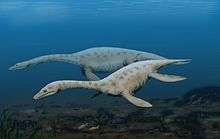Augustasaurus
| Augustasaurus Temporal range: Middle Triassic | |
|---|---|
 | |
| Skull of Augustasaurus hagdorni in the Field Museum of Natural History, Chicago | |
| Scientific classification | |
| Kingdom: | Animalia |
| Phylum: | Chordata |
| Class: | Reptilia |
| Superorder: | †Sauropterygia |
| Clade: | †Eosauropterygia |
| Clade: | †Pistosauroidea |
| Clade: | †Pistosauria |
| Genus: | †Augustasaurus Sander et al., 1997 |
| Type species | |
| †Augustasaurus hagdorni Sander et al., 1997 | |
Augustasaurus is a genus of aquatic sauropterygian reptile belonging to the Pistosauria, a clade containing plesiosaurs and their close relatives. Pistosaurus and Augustasaurus were thought to be the only known members of the family Pistosauridae.[1] However, some recent cladistic analyses found Augustasaurus to be a more advanced pistosaur, as a sister group of the order Plesiosauria.[2][3] The only known species of Augustasaurus is Augustasaurus hagdorni , which was first described in 1997.
Etymology
The first part of Augustasaurus' name comes from the Augusta Mountains of northwestern Nevada,[4] USA, where its fossil bones were first discovered.[1] The second part of the name is the Greek word sauros (σαυρος), which means "lizard" or "reptile."[4] The type species, Augustasaurus hagdorni, was named in honor of the paleontologist Hans Hagdorn.[4]
Description

Augustasaurus' skull shares many general characteristics with its relative, Pistosaurus, such as tall, blade-like upper temporal arches.[1] The skull's elongated rostrum tapers to a dull point, the anterior premaxillary and maxillary teeth have been described as "fang-like",[1] and the squamosal makes a box-like suspensorium.[1]
The dorsal neural spines of Augustasaurus are low with rugose tops.[5] Its coracoids are large plates similar to those in other plesiosaurs.[6] However, the coracoid foramen are missing from Agustasaurus, in a way similar to those in the pistosauroid Corosaurus.[6] Its cervical ribs have anterior process,[7] and like most plesiosaurs, Augustasaurus' vertebrae have "thickened transverse processes".[7]
Distribution
Augustasaurus is known from the Augusta Mountains of northwestern Nevada (United States). The holotype specimen was found in the Favret Formation, which dates from the mid-Triassic period, of Pershing County, Nevada.[8]
See also
References
- 1 2 3 4 5 Journal of Vertebrate Paleontology. Article: pp. 577–592. THE SKULL OF THE PISTOSAUR AUGUSTASAURUS FROM THE MIDDLE TRIASSIC OF NORTHWESTERN NEVADA. OLIVIER RIEPPEL, P. MARTIN SANDER, and GLENN W. STORRS. 1997
- ↑ Cheng, Y.-N.; Sato, T.; Wu, X.-C.; Li, C. (2006). "First complete pistosauroid from the Triassic of China" (PDF). Journal of Vertebrate Paleontology. 26 (2): 501–503. doi:10.1671/0272-4634(2006)26[501:fcpftt]2.0.co;2.
- ↑ Hilary F. Ketchum & Roger B. J. Benson (2011). "A new pliosaurid (Sauropterygia, Plesiosauria) from the Oxford Clay Formation (Middle Jurassic, Callovian) of England: evidence for a gracile, longirostrine grade of Early-Middle Jurassic pliosaurids". Special Papers in Palaeontology. 86: 109–129. doi:10.1111/j.1475-4983.2011.01083.x.
- 1 2 3 "Plesiosaur.com entry on Augustasaurus". Archived from the original on 2007-12-10. Retrieved 2008-07-16.
- ↑ O’Keefe. Pg.52
- 1 2 O'Keefe Pg. 5
- 1 2 O'Keefe. Pg. 51
- ↑ O'Keefe Pg.9
External links
- https://web.archive.org/web/20081120014242/http://www.vertpaleo.org/publications/jvp/22-577-592.cfm
- https://web.archive.org/web/20071210085257/http://www.plesiosaur.com:80/database/genusIndividual.php?i=32
- https://web.archive.org/web/20081005203917/http://www.palaeos.com:80/Vertebrates/Units/220Lepidosauromorpha/220.400.html